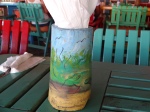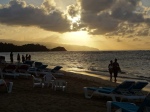Samaná (Pt 1)
Hola,
¿Qué lo qué? (what’s up?). This weekend we had a great, great adventure to a wonderful land called Samaná, which is on the northeastern part of the island and is part of the Samaná Bay. (See the map below- I am in Santiago, which is closer to the northern part of the country, while Samaná is to the east, near where it says Oceano Atlantico on the map).
We spent the entire weekend at a kick-ass resort called Hotel Colibri (hummingbird). The rooms were really cool because they were basically mini-apartments, complete with a kitchen, tv, balcony, and everything. The view from my room was spectacular, it was almost unreal. It was a four hour drive to get there, so we had to leave reaaaaly early in the morning…but it was totally worth it. So the first day, we went on a little excursion, and we had the choice between going on a hike to a waterfall or visiting a neighborhood that was populated by former African-American slaves who were invited to live in the DR while it was under Haitian rule. There were roughly 2,000 ex-slaves who took up the offer and moved to Santa Barbara de Samaná. The neighborhood is called Barrio Willmore. It was really interesting because they mostly kept up a lot of their Southern-American customs, like speaking English (though nowadays the younger generations are kind of losing that), eating Johnnycake, and having traditional American names (for example Johnson, Smith, etc.). We spoke with a woman named Martha Willmore, who’s great-grandparents came to this country. It was pretty incredible because many of these slaves came during the 1820s I believe, which means her family members lived for an absurd amount of time. She swears some of her relatives lived until 149, and she herself is in her 80s. The other interesting thing is that while they speak English, they speak an “old English” that people spoke in the 1800s. I guess I hadn’t thought about it too much, but for some reason I had envisioned them speaking today’s English and stuff. It makes sense, though, that they would speak an antiquated version of English- the English they learned came from their parents and grandparents, who left the U.S. in the 19th century! Isn’t that crazy?
Our tour guide also gave us some more insights into the culture in Santa Barbara de Samaná: not only is their English an old English, but it also has French/Haitian influences since Haiti shares the island, Caribbean English, and of course Spanish. In addition to speaking English at home,the descendants of these former slaves had to learn Spanish in school and to converse with other Dominicans. It was also enlightening to learn that many of the younger kids are kind of rejecting learning English and instead would rather speak just Spanish. There’s a lot of history there. For example, the reason the Haitian president Boyer invited the slaves there was to “populate” (there were already indigenous people living there, hence the quotation marks) the area so it wouldn’t be overrun by the French again. And I bet there’s a bunch more. But anyway, Martha was very sweet and in really good health for a woman her age. She was telling us about growing up in Samaná back in the day. In fact, until a few years ago she lived and grew up in the house her father had built for mother way, way long ago. Fascinating!
After that, we had a beautiful dinner on the beach. I had a delicious meal that consisted of coconut shrimp, french fries, bread, and chocolate mousse for dessert. The food in itself was awesome, but being on the beach made it even better!! After that, we hung out and just relished in being on an amazing beach and sweet hotel for the weekend.
- The view of the ocean as we were driving to Samaná
- Cool motorcycle I saw
- There was also a cave on the side of the highway!
- The road that led us to Samaná
- Beautiful!
- The view from my hotel room! You could see the pool and the ocean simultaneously
- the balcony
- Cool art on the way to lunch
- calamari, chicken, rice, beans, veggies, bread, and fruit for dessert
- Martha Willmore’s house
- She made us English bread, which was DELICIOUS
- Group photo
- This is the house she was born and raised in
- Our hotel was right on the beach
- The hotel was so fancy, we walked on clovers not grass!
Part two coming soon,
Megan


























This is really cool sis. I hope you’re having a fun time, especially with you getting your nose pierced and stuff. Make sure you bring something back for us!